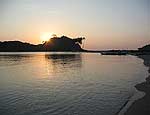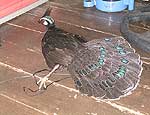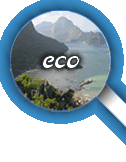
 » info
» info
» fun
» go
» talk
» eat
» sleep
» scuba
» eco
|
|
eco
El Nido as a Protected Area
 The sheer drama of the seascape of El Nido inspires awe and reverence of nature's beauty. Beyond the fašade, this spectacular setting is home to a wide range of flora and fauna, many of which are endemic or found nowhere else on earth. The sheer drama of the seascape of El Nido inspires awe and reverence of nature's beauty. Beyond the fašade, this spectacular setting is home to a wide range of flora and fauna, many of which are endemic or found nowhere else on earth.
It is because of its uniqueness that the El Nido-Taytay Managed Resource Protected Area was declared in 1998. The Protected Area status accords the area of El Nido a place among the 10 priority sites in the Philippines in need of conservation. The Protected Area covers a total of 90,321 hectares, of which 40% are terrestrial and 60% marine.
What needs protection?
- 5 types of forest: lowland evergreen, semi-deciduous forest,
forest over limestone, beach forest and mangrove forest
- 3 major marine habitats: seagrass/seaweeds, coral reefs and estuarine
- 16 endemic and 10 threatened species of birds
- 6 species of marine mammals endemic to Palawan, plus the endangered dugong
- 4 species of endangered marine turtles: hawksbill, olive ridley, leatherback and green sea turtles
- 45 genera of hard corals
- 197 species of fish
- White sand beaches
- Limestone cliffs jutting hundreds of feet straight up to the sky, with thousands of caves cradling swifts' nests. The nests are made into the prized Chinese delicacy nido soup and worth their weight in gold
Why does El Nido need protection?
 The pristine beauty of El Nido depends upon the state of its environment. The plants and wildlife will thrive only as long as their habitats remain conducive for them to grow and breed their young. Unfortunately, it is the very richness of El Nido's natural resources that makes it attractive to poaching, both from forests and coral reefs. Patrolling is therefore necessary to prevent, and when necessary apprehend, environmentally destructive activities such as illegal fishing and logging. The management of wastes generated by households, tourism and agriculture is another component of managing the Protected Area. Protecting El Nido means protecting the delicate balance of nature that engendered this special place. The pristine beauty of El Nido depends upon the state of its environment. The plants and wildlife will thrive only as long as their habitats remain conducive for them to grow and breed their young. Unfortunately, it is the very richness of El Nido's natural resources that makes it attractive to poaching, both from forests and coral reefs. Patrolling is therefore necessary to prevent, and when necessary apprehend, environmentally destructive activities such as illegal fishing and logging. The management of wastes generated by households, tourism and agriculture is another component of managing the Protected Area. Protecting El Nido means protecting the delicate balance of nature that engendered this special place.
What can you do to help?
 Visit El Nido and pay the conservation fee. Like most of the world's Protected Areas in developing countries, El Nido suffers from lack of funding to protect and manage its natural resources. The Philippine government does not have enough funds to allocate the estimated $180,000 needed annually to manage the Protected Area. By paying a mere $0.50 per day for the duration of your visit, you help augment the funds needed for patrolling the area and guarding against illegal fishing and logging. You could pay the conservation fee at your resort, the Municipal Tourism Office or the Protected Area Office, both of which are housed in the same building in the middle of town. Visit El Nido and pay the conservation fee. Like most of the world's Protected Areas in developing countries, El Nido suffers from lack of funding to protect and manage its natural resources. The Philippine government does not have enough funds to allocate the estimated $180,000 needed annually to manage the Protected Area. By paying a mere $0.50 per day for the duration of your visit, you help augment the funds needed for patrolling the area and guarding against illegal fishing and logging. You could pay the conservation fee at your resort, the Municipal Tourism Office or the Protected Area Office, both of which are housed in the same building in the middle of town.- Be an environment-friendly tourist. The adage, 'Take nothing but pictures, leave nothing but footprints, kill nothing but time' may be over-used, but the soundness of the advice certainly hasn't diminished. During your visit, try to do the least damage to the environment.
 Try not to step on or break off branches of corals. Save energy by turning off lights and appliances when you leave your hotel room. Conserve water, and take your garbage back with you especially when you explore the secluded beaches on more than 40 islands dotting the turquoise sea. Also, be careful when buying souvenirs, because they could end up costing a lot more than you paid for them. Think twice before you buy any products made from plants and wildlife, including tortoise-shells and corals -- they could be endangered species and trading and transporting them will therefore be illegal. Lastly, give feedback. If a tour, tourist service, or hotel was environmentally sensitive and informative, or if it could have been better, tell the owner or operator. Try not to step on or break off branches of corals. Save energy by turning off lights and appliances when you leave your hotel room. Conserve water, and take your garbage back with you especially when you explore the secluded beaches on more than 40 islands dotting the turquoise sea. Also, be careful when buying souvenirs, because they could end up costing a lot more than you paid for them. Think twice before you buy any products made from plants and wildlife, including tortoise-shells and corals -- they could be endangered species and trading and transporting them will therefore be illegal. Lastly, give feedback. If a tour, tourist service, or hotel was environmentally sensitive and informative, or if it could have been better, tell the owner or operator.
- Tell others about El Nido and the need to protect its environs. Visiting El Nido as an eco-friendly tourist means you help the local economy while helping save the environment. Visiting El Nido would also help you, your family and friends appreciate the majestic beauty of nature.
|
|










